IT’S ABOUT TIME I told you the story of my brush with Hollywood fame, a highly prized part of my education. Think of it as a roadmap around the hazards of groupthink; a peephole into the reality of the Nobody Knows Anything principle.
Nobody Knows Anything is how the great William Goldman summed up the moviemaking business. It may sound like cynicism, even nihilism. It’s anything but. Nobody Knows Anything is verified, bona fide, uncontradicted by observed phenomena. Science, you might say.
Goldman was talking about being willing to defend your own ideas when someone wraps themselves in the mantle of authority and tells you they know how an audience will react to this concept, this script, this narrative structure, this character, this approach.
They don’t know.
Over the years I’ve come to appreciate that Nobody Knows Anything has a charitable dimension as well. I used to think the movie I worked on was a train wreck because key people in management were magical thinkers, corner cutters, bullshitters and deadbeats. The truth is, even people like that don’t start out trying to make a bad movie. They just don’t know how to make a good one. No one does.
Not until the movie does well or poorly. Then they’re hailed as visionaries, or mocked as fools.
Speaking of the latter, I’d like to know who wrote this groaner of a title. Good grief… a golf pun.
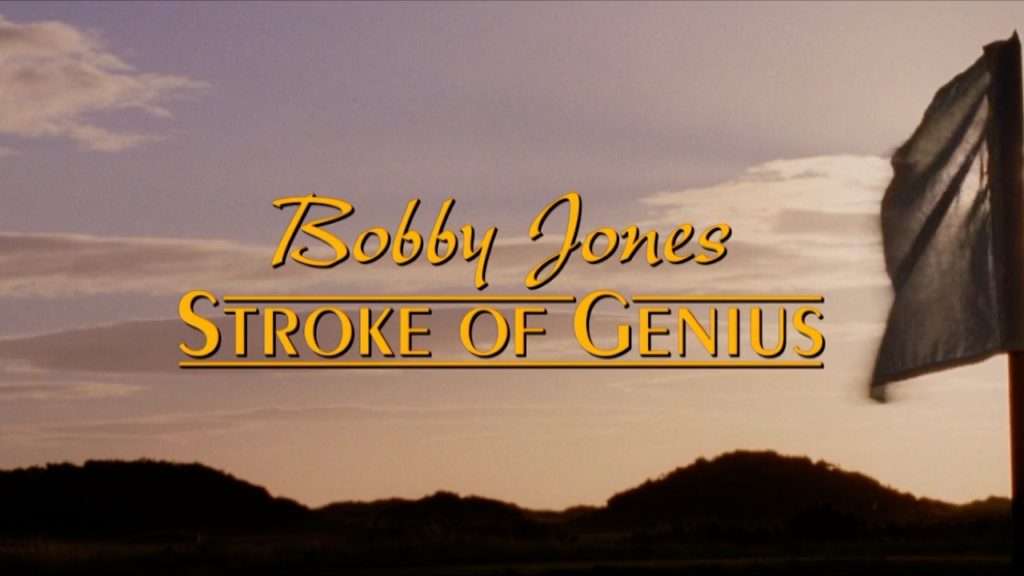
I’m pretty sure my forehead bounced off the top of my desk the first time I heard it.
The on-screen writing credits show three of us scribbling away on this turkey over the course of 14 years.

There’s a subtle industry format here, an encoded message from the Writers Guild of America: when you see an ampersand between the names, that means the writers worked together as a team; the word and signifies the opposite, that we three never worked on the script together. That’s true. There was zero collaboration.
I was replaced by a guy who couldn’t write a grocery list. He, in turn, was replaced by a guy who could write a grocery list.
Investors lost $17 million. Or $20 million. Or $32 million. Or some other number entirely, depending on which unreliable source was talking to the trades that day.
The way to watch this movie is to skip the first 35 minutes. They’ll try your patience and sap your goodwill. If you watch from the beginning you might accidentally put your head in an oven and never see the rest.
Eighteen producers. That’s right. Eighteen cooks in the kitchen. So right away you know things are bound to turn out well.
The movie was in and out of theaters in two weekends. But the good thing is: now you can go around telling people you know a guy whose name is on the Second Biggest Limited Release Box Office Bomb of 2004.
And you might want to mention that four times a year, without fail… I get a residuals check.

Oh, sometimes it’s more than 14 cents… a hundred bucks for motorcycle parts, two hundred now and again… But this is the check that makes me smile.
It’s hanging on my office wall.
Now let me tell you what went right:
The photography is gorgeous, thanks to the talents of Tom Stern, one of the very best cinematographers and lighting experts alive. He did Mystic River, Clint Eastwood’s Iwo Jima movie, lots of things you’ve seen.
The score, by the late James Horner, another high point. At least in the parts worth watching. Even he couldn’t save the first 35 minutes.
Top honors go to the cast, gifted professionals who put it all on the line and did their best to make a bad script work as well as it possibly could.
Start with the leading man, Jim Caviezel, as Bobby Jones.
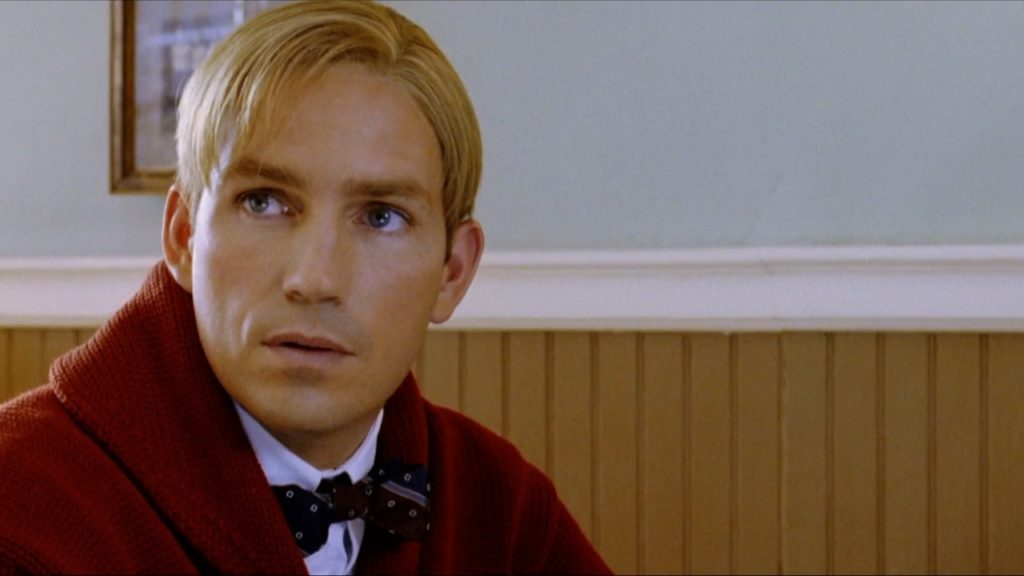
A real talent and a helluva nice guy (though in recent years, some reports have him going around the bend in a Mel Gibson sort of way, sorry to hear that if it’s true). On set in Atlanta I’d just been completely bashed up in a motorcycle get-off. Jim appeared genuinely concerned for my wellbeing as I hobbled about on a cane, chatting with him between takes.
I’ve always gotten a chuckle out of this pic from 2004. That’s Daughter #2 on the left. She’s checking out Jim’s abs at Tavern on the Green, in Central Park. In the venue’s heyday in the 70s and 80s, that’s where every New York premiere had its after-premiere party. That’s how you could tell you were in the movie business, you’d be all spiffed up and find yourself at Tavern on the Green.
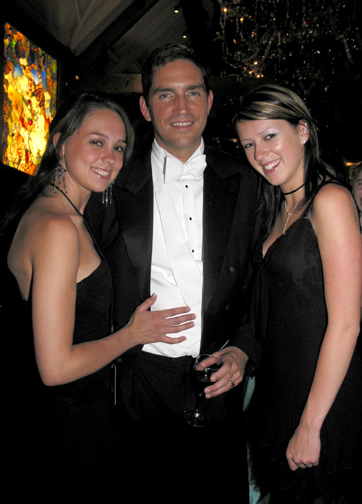
Funny thing: D2 is in the business today because of my Bobby Jones misadventure. She was a student at Northeastern at the time, insisted on coming to Atlanta with me because I’d been freshly wracked-up in the Super Glide get-off. Ten days on the orthopedic floor at Rhode Island Hospital getting bones screwed back together.
They made her an extra in the movie. Curled her hair, put her in a 1930’s dress…
That’s my cutie on the left.
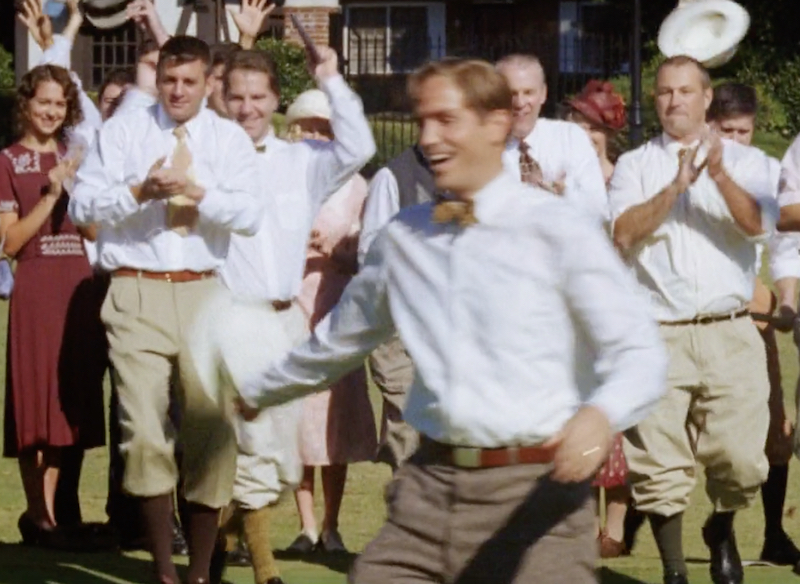
When we got back from Atlanta, she changed her major to theater & film. Now, 16 years later, she’ll be back in Georgia in a few weeks as production supervisor on a movie. One of those strange twists & turns in life.
For years, the joke around here has been that D2 will produce all my scripts when I’m haunting my urn.
Our leading lady, Claire Forlani as Mary Malone Jones, Bobby’s wife.
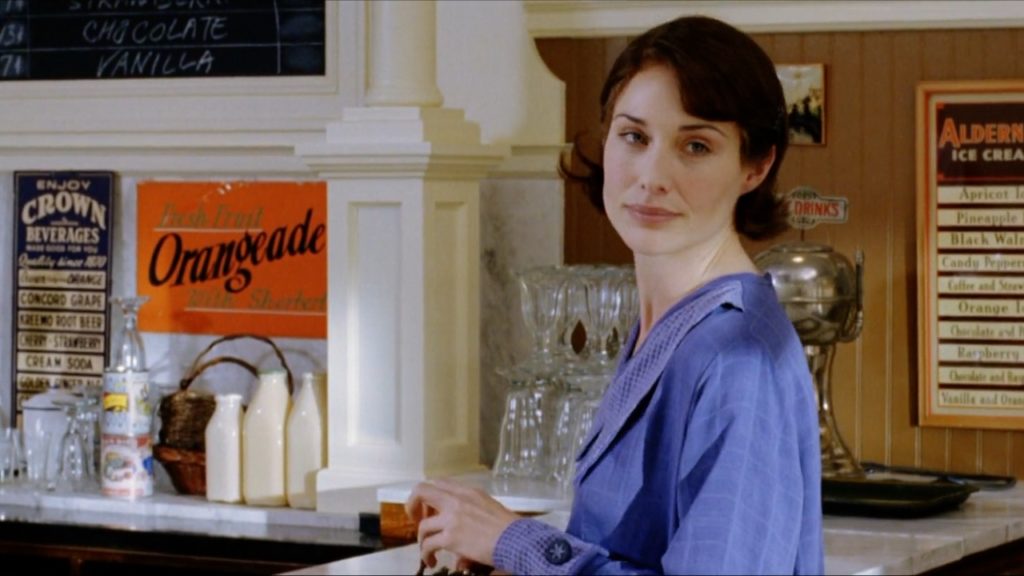

It’s not camera magic; she’s startlingly beautiful from three feet away, in any light.
Sneaking up on 50 nowadays, she’s better than ever. Now she’s been around long enough to be interesting as well as stunning.
Malcolm McDowell as O.B. Keeler, Bobby’s golf-writer friend, mentor and confidant. Wonderful actor.
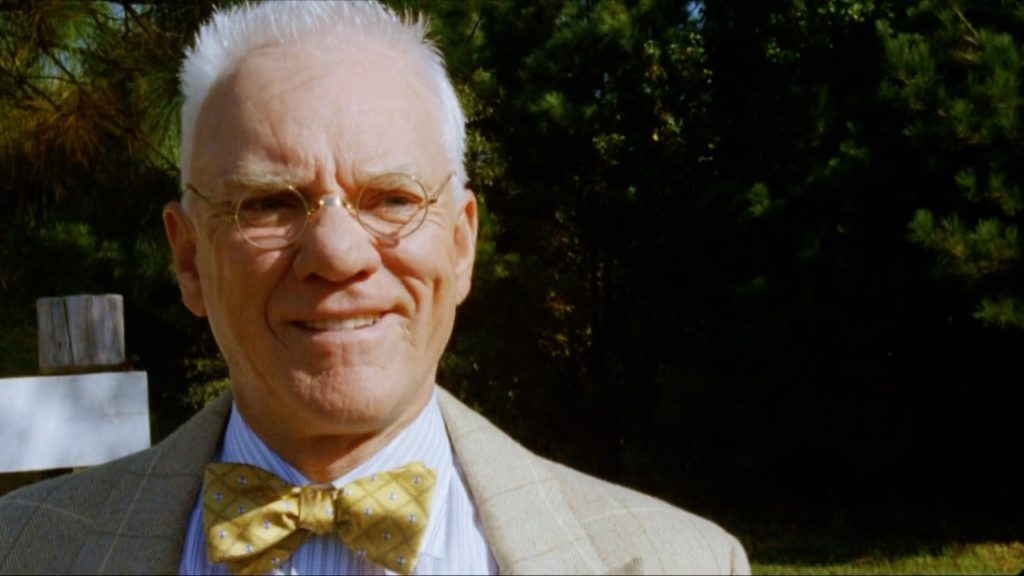
As a wiseguy reporter myself in those days, it appealed to my sense of mischief to have O.B. punch a wiseguy reporter in the nose. It’s a fun scene, even if the director did push it a beat too far. He had O.B. make a speech after punching the guy. I’ll show you a clip of that below.
There are other actors worth mentioning but I’ll quit here with Jeremy Northam as Walter Hagen. He was the most fun of all to write.
Hagen was the foil to Bobby Jones, the dissolute pro versus the squeaky-clean amateur.

I wrote a scene where Hagen arrives to compete in a tournament after a wild night out. He wakes up in the back of a rented car wondering where the girl went. He oils his hair, brushes his teeth with a nip from his flask, does deep-knee bends in his rumpled tuxedo. He shamelessly bums gambling money off his chauffeur—and you love the guy for it. Got a clip of that below, too.
First, let me back up and give you the travel in a nutshell:
In 1990, Cameron “Kim” Dawson, a producer I was acquainted with on the Disney MGM lot in Florida, hired me to write an original screenplay on Bobby Jones and his “Grand Slam” year of 1930. Jones, if you don’t know, swept the U.S Open, U.S. Amateur, British Open and British Amateur, all in the span of five months.
It had never been done before. It hasn’t been done since.
Bobby Jones won it all. Then, at 28, he quit. Never turned pro. He left millions on the table and walked away from an adoring public. He went home to Atlanta to decompress and turn his attention to being a family man. He wanted to lead an ordinary life out of the public eye.
A man like that, what’s he really like between the ears? I was delighted to get the opportunity to try to figure it out.
I wrote the script, Kim pronounced it “brilliant” (it was far from that, but a good start), said it was exactly the right way to tell the Bobby Jones story. Keep the movie centered in 1930, the Grand Slam year. Kim told me Jack Lemmon read the script and said good things about it.
Kim got actors together, did table readings, enthusiasm was high—we were on our way! Time to start practicing our Oscar speeches.
Then, as often happens, the project went into development hell, where the groupthink takes over and Nobody Knows Anything. There it wheezed away year after year on life support.
Some of the Jones heirs were an unwieldy and meddlesome influence. At one point they insisted on bringing in a new writer to start over from scratch; a guy who had crewed on a few T&A movies in the 90s and happened to live next door to a Jones heir. They must have thought that was kismet.
To my knowledge, not a word of the Bill Pryor script made it onto the screen. At least I don’t see it there. When Kim asked me to read Pryor’s script I provided him with eight or nine pages of coverage on how and why it was rubbish. Literally unfilmable.
Told you about the 18 producers who coalesced around the project after I filed my script. Well, once in place, the brain trust put Rowdy Herrington at the helm, a director who had never made a well-reviewed movie. One stinker after another.
Not because he’s a bad person. I met him, talked with him, not a bad fellow at all. He just works in a business where Nobody Knows Anything. Especially not him.
Rowdy wanted to draw from my script but mainly write his own, snag the top writing credit for himself, the story credit. Well, they put the reins in his hands and my information pipeline to Kim started to dry up. Rowdy didn’t want me anywhere near the project. I’ve never seen his shooting script.
When I introduced myself to Rowdy on set in Atlanta, he held forth, a bit defensively, I thought, on how collaboration is the nature of the business. He seemed to think it meant people working toward the same goal in a serial manner, like runners in a relay race. And now he, as writer-director, has got the baton and it’s all up to him.
He went on to deliver, for my benefit, I suppose, a primer on how “story arc” works. This, while filming his arc wherein the first 35 minutes are a complete waste of the viewers’ time.
I knew, at that moment—thought I knew, given that Nobody Knows Anything—the enterprise was doomed. I suspect he read it on my face, because he got a little frustrated with me as he went on and on about the craft and I’m standing there thinking oh my god oh my god oh my god… this is the guy… and he doesn’t know how to do this.
He had incorporated about 10 percent of my script into his, a page here, page there, scribbled the rest on his own. And the whole project, with so much going for it—a superb cast, the score, a reasonably “big” budget—went right in the tank.
How does this work, you may ask? How does someone get the top job when they’ve had more than their share of at-bats and can’t get on base?
This is not to pick on Rowdy. Again, he’s not a bad human being. But when you’re in, you’re in. Producers and financiers would rather deal with the guy they know who doesn’t know anything. They get nervous taking a chance on someone they don’t know who doesn’t know anything.
The business is full of these in-guys—and I do mean guys. If a woman fails the first time out, she’s done. Marked forever.
Hell, a female director can succeed the first time out and never get a second shot.
Rowdy had opportunity after opportunity and it all led to a script that was alternately plodding, precious, tedious, solemn and played like the Hallmark Channel. And, really, golf was the star of his movie. That was a complete 180 from the instructions I’d been given in 1990.
Back then, the guiding principle was: This is not about golf in the same way that Chariots of Fire is not about running.
I understood immediately: Searching for Bobby Fischer is not about chess, Little Man Tate is not about math… I’m there. But 14 years later, Kim shared story credit with Rowdy. I can only guess that he, over time, had gotten on board with the groupthink.
People get carried along, it’s the human condition. Hope supplants reason, and folly ensues. There’s time invested, money spent, finally a bit of momentum, gotta keep that going, the movie’s got to get made—it’s just got to!
My Bobby Jones movie was centered on the man, the times, his place in them, what he believed, how he struggled to compete, how he was driven to win despite the crushing physical and mental price he paid. He navigated the pitfalls of fame with his integrity intact, resisted the temptation of easy money, did right by his family, all that.
Bobby Jones would have hated this project even if it had turned out well; his heirs trying to cash in on his fame, hawking $350 polo shirts with his name on the pocket… Talk about irony.
Well, the movie Rowdy ended up writing was golf, golf, golf. I counted 119 golf shots before you even get to the golf part.
Maybe that’s not surprising when you look at the biggest financial backers who gravitated to the project. It was a clique of rolling-in-dough golf-crazy muckety-mucks who spend at least part of the year in Jackson Hole, Wyoming.
A few have reflected poorly on themselves in the years since. One was in the news for illegally building a 13,000-square-foot house in Jackson Hole when his building permit said, you know what, Richie Rich? hold up at 10,000 square feet, pretend you’re roughing it. He fought the county all the way to the Wyoming Supreme Court; lost again there and paid a $714,000 fine.
Another one, such a wheel his name appears twice in the credits, ended up going to prison for financial fraud in 2015. He had bilked an elderly widow out of $1.1 million, then tried to hide $148 million in assets from the U.S. Bankruptcy Court in his Chapter 7 case. Oops…
Here are a few clips of some of the scenes I wrote. That doesn’t mean I own them—I don’t—but I hereby claim fair use for the non-profit educational purposes of the Nickels.
I like this first one, where Bobby and O.B. switch medications. The meds are real but the switch never happened. Artistic wiggle room abounds, given that this isn’t a documentary, it’s a feature film.
O.B.’s medication was a flask of corn liquor; Bobby’s, a bottle of paregoric, an opium-based elixir he would take for his stomach. And to quiet the symptoms of a neurological disorder that would eventually end his life.
Here’s another scene I invented just for fun: Bobby Jones is such a natural he can time the rolling Atlantic and sink a serpentine 40-footer on the deck of a ship.
It works beautifully with no dialogue, which is how I wrote it.
Up next, Walter Hagen’s big entrance. I wrote the chauffeur part for a black actor. I liked the idea of the working man in Jim Crow Dixie getting leaned on to subsidize his boss’s gambling habit, and not being reluctant to point that out.
Blacks are all but invisible in the reference materials on Bobby Jones. They mostly stand around holding golf bags on their shoulders. Which is what they do in Rowdy’s movie.
He wrote one speaking part for one black actor with one minute of screen time, total. And the first half of that minute is a racial trope right out of Gone With The Wind. It’s mammy caring for wee sickly Bobby in that awful first 35 minutes.
She’s a caricature, a stereotype. As wide as she is tall, unfailingly cheerful, lives only to serve. The brain trust probably thought it was charmingly nostalgic.
Later, she smiles through a 30-second browbeating by Bobby’s grandfather, a surly old codger. He lectures mammy on the fact that, no, he would most certainly not like to be served a “Co-Cola,” thank you, Co-Cola is not mentioned anywhere in scripture.
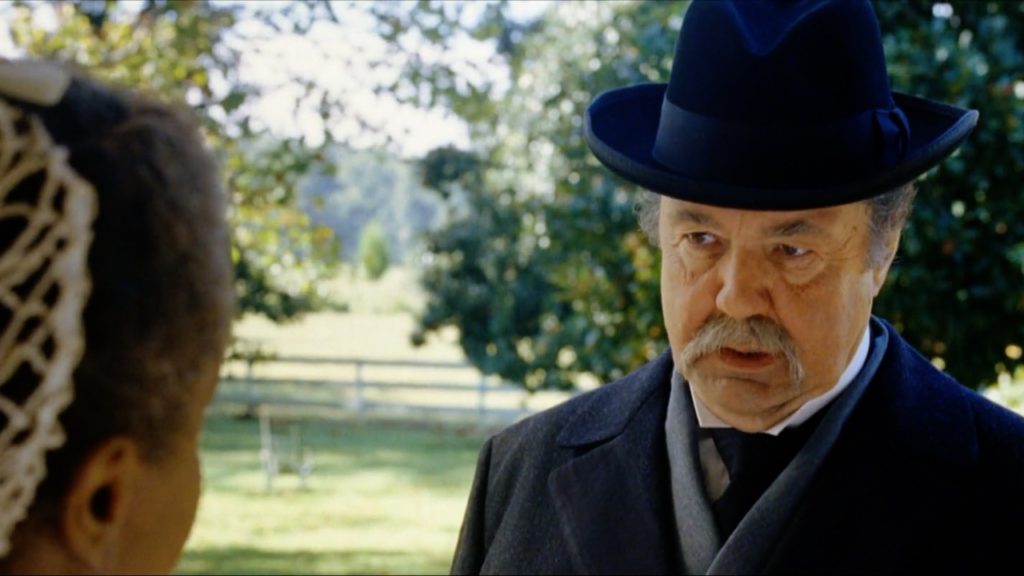
Every movie ought to get off into those weeds, don’t you think?
The race weirdness of this entire production really shows in how they staged this next scene I wrote, vetoing the black actor I wrote it for. No no no, we can’t have period-correct African-American dialect, we’ll be criticized. Let’s get some other guy who’s not white to do it. And give him some kind of dang fereigner pidgin to speak.
Here’s another Hagen/Jones scene I wrote, one that goes to the nature of their rivalry, the mercenary pro v. the true amateur.
Here’s O.B. serving a knuckle sandwich to a pain-in-the-ass reporter. I pulled it out of thin air, just for fun.
The way I wrote the scene it ended right after the punch. Rowdy added O.B. making a speech about what a great guy Bobby is. Hero worship afflicts the movie from the title on through to the credits, and it’s just so in-your-face obvious and ham handed. Rowdy doesn’t show, he tells. It’s a hectoring, pedantic way of writing.
Despite how it ends… I do like this clip.
Here’s another one with a completely unnecessary closing line added. Yet another lecture about how Bobby’s a genius, a legend, a god.
My script ended the scene on “Go to hell, Hagen.”
So that’s the story of my screenwriting breakthrough that never happened.
And now for the kicker: after blowing through untold millions and steering the whole enterprise off a cliff, the producers burned me on my contract.
I was working for cheap, trying to break in. I had agreed to write the script for 50 percent of WGA basic minimum. At the time, that meant something like $9,500 up front to produce an original script, a rewrite, and a polish, and $42,500 deferred until such time as the movie might be produced.
In fact, I did quite a lot of unpaid work in the early years when Kim was trying to get the ball rolling and attract new production partners, new financiers. Based on feedback he was getting from industry readers (and those unhelpful Jones heirs) I easily did four full rewrites for no additional money.
The producers bet everything on a grip/best boy electric/gaffer who had climbed the ladder to become a mediocre director, but what he really longed to be was a writer. They burned through their investors’ millions like it was Monopoly money, then turned their pockets inside out when it came time to pay me the $42,500.
They asked me to sign an entirely new deal accepting $25,000 as final payment. I thought, you know what? taking these numbnuts to court over the difference I’ll easily spend the difference, so… I signed.
As soon as I did, they said we don’t have the $25,000 either.
So I did sue them at that point. And Norris Adams, a hardworking lawyer in North Carolina, managed to recover some of what they owed me.
It’s so common to hear people badmouthing lawyers. I always think: You’ve never been t-boned by a careless driver, have you? Never been cheated out of your labor or your intellectual property and needed a smart advocate on your side? I’ve been fortunate to have highly capable lawyers come to my aid, as needed. Guys whose initials are Michael Schwartz, Norris Adams, Eric Rayman.
Hats off to these gentlemen! We need them out there fighting for us working slobs.
By the way, I was merely among the minor creditors. The company stiffed the Golf Channel for $300,000 in advertising (while doing the channel the courtesy of a thank you in the credits, make of that what you will).
In the end, the movie didn’t do anything good for anybody’s career. That must come as a shocker.
Rowdy never directed again; though for all I know he never tried to get another directing job. It’s not like we’re pals and I’m hip to the aspirations he entertained after having a stroke of genius right out in public like that.
Supervising producer Rick Eldridge of ReelWorksStudios is still in the business, albeit making flops for a niche audience of crackpots.
In closing, and in the spirit of Nobody Knows Anything, allow me to step up and concede what you must be thinking by now: that if things had worked out differently…
Let’s say the stars had aligned and I’d had the opportunity to write for an A-list director, my dream director; a Bruce Beresford, say, someone interested in a true collaboration among colleagues. Isn’t it possible that my script would have been as big a bomb as Rowdy’s?
Well, hell yeah, it’s highly possible!
I won’t try to tell you that what I missed on the Bobby Jones fiasco was my Hollywood breakthrough tied up in a bow. It was merely the possibility. You take your shot, see what happens, next thing you know you’re certain to be labeled one or the other: a visionary or a fool. In hindsight, everybody saw it coming a mile away.
Want to know what that was like, not finding out? Take it from the great Burt Lancaster, as Doc Graham. In his youth, as Moonlight Graham, his one shot at the majors had come and gone in half an inning.
See what I mean? Burt’s been around long enough to know that nobody, but nobody, knows anything.
Tony DePaul, March 5, 2020, Cranston, Rhode Island, USA


I took all my humanities requirements in film classes. I love film.
I’ve gone to any number of films intrigued by the premise only to find that it had “slipped through the fingers” of the makers. Obvious flaws, missing scenes that should have been there, squandered opportunities. Patronizing dialogue.
Now I have an example of how and why it happens.
Haven’t seen the film, but your shot aboard the ship is pure cinema, indicating the skill of the golfer in solely visual terms. Well done!
Keeping it to the key year in Jones’ career was a sound decision. Film is compressed story telling.
For another endless scene see the final fly casting sequence in “A River Runs Through It” and compare it to the prose story.
You indicate key scenes were spoiled by additional dialogue you didn’t write. Any chance the film could be saved by another editor?
I hadn’t thought of that, Robert. I tend to doubt they have the coverage to do something about that first 35 minutes. Hard to say.
Even if they did, recutting, advertising, distribution… Whoever was asked to fund it would likely see the first go-around as a cautionary tale.
Thanks for this fascinating look into the world of movie-making. I think this blog is one of the best, if not the best, you’ve written, and that’s saying a whole lot, because I love them all.
What a fun way to start my Sunday morning! Best thing I’ve read in some time.
Wow Tony, I loved the background on the movie. Obviously, I am not a critic, but loved the story and see where you influenced it. You are a great writer, it is a privilege to know you. When you are mended, lets talk about SA. Probably when I get back from Alaska?
There may be a cheeper way to do Chile and Argentina? Buy and resell bikes locally. More later. Write some more of this type of interesting prose. Your fan base is growing as we speak. Heal fast, keep the rubber down.
I loved the story and loved the clips. I think I would love the movie, albeit in inferior “Tony got screwed” format, mainly because of my love for golf. You always inspire, and the truth-speak you provide is a rare commodity these days. Get well brother.
Thanks so much for reading, all. I appreciate your comments.
This was a long one. I almost wanted to break it up into two parts. Didn’t think anybody would read it as-is.
It gave me something to do while bouncing back from round 5 and getting ready for 6. It was fun to write something that didn’t even reference that whole thing.
Tom, yeah, I guess the money comes from Amazon sales, streaming outlets, etc. I’ve been told they show the movie on airplanes. Captive audience, no parachutes…
Tony, where’s the best place for an ordinary viewer to find this relic these days? Netflix, YouTube Movies, Amazon remainder bin, eBay? It must be generating a few dollars somewhere if you’re getting those whopping 14-cent checks.
That was an excellent read Tony. I was pleased that your idea of a great director is my fellow countryman Bruce Beresford, a man who in my opinion has directed very few stinkers.
If you haven’t read it, you should get hold of Bruce’s 2007 memoir entitled “Josh Hartnett Definitely Wants To Do This… True Stories From A Life in the Screen Trade.”
It would ring some bells with you, a tale replete with projects that went nowhere. Gave me some idea of what directors actually do in the intervals between one feature film and the next.
Wonderful story, Tony. I always knew that I didn’t know anything. It’s somewhat comforting to learn that Nobody Knows Anything. At least I’m in good company.
Tony, this post is one of my favorites that you have written. To be honest, I liked this movie. Sure, it’s a clinker at first, but it does go to the heart. I don’t care about the Hallmark Card factor. It was a hit with me. But then, Nobody knows anything…
As always, enjoyed the read. Thanks Tony. I find it funny “nobody knows anything “ and “they keep women out “. Maybe that’s why nobody knows anything! Just saying…..
Loved reading your tale of Hollywood.
I’ve done BG work with some of those folks and know that some A-listers are A-holes but most are not.
Saw Laura in The Wrong Todd.
We need GG!!!
Ha! That’s funny. Never thought anybody would see that film. Seems to be getting out there one way or another as of late. I was in it just as a favor for a pal and I worked behind the scenes as a go-pher for a week.
My one and only brush with Hollywood. “The Patriot” with Mel Gibson, I got a call from Sony Studios to supply the furniture for the movie from my store. Man, were they tough to deal with. “We want net 90 terms” (ahhh, no. It’s prepaid since I have to have it all made). “We need it on set in North Carolina in 4 weeks (Try again, 7 weeks is best I can do, it has to be made). Then after I told them the price, they called back and demanded a 20% discount. I asked if my store “The Keeping Room” would be in the credits and they said absolutely not – to which I replied there would absolutely not be a discount!
We used D.R.Dimes out of New Hampshire to build all the pieces, and the son was SO EXCITED that he drove all the furniture down to the set in North Carolina so he could be on site. I could care less, I got paid. The set people called me up after they got the chairs (see the opening scene, we made fourteen of these that Mel breaks), and said the chairs would not break. Of course not – they are not made to break. I suggested they take a jig saw and score the legs and spindles so the chairs would collapse when thrown, saw then 2/3 the way through.
https://www.youtube.com/watch?v=2lvz3v_dtyA
At the end of filming Sony called me back up and wanted me to buy all the furniture back. I declined. Cheap bastards!
I’ve pretty much decided that all movies are a remake of a prior movie. Watched Avatar the other night and its nothing more than Blue Man Group meets Dances with Wolves, Alien Style. Do-good salt-of-the-earth warrior meets foreign culture and becomes enlightened they are the True Choice, then becomes their Primary Badass and lead savior. Dances with Wolves probably ripped off some other movie, I’m not interested in it enough to track that down. But I bet it did.
Let’s hope you still get a second chance. I know you have been working on a great script.
Thanks for the shout out.
Take care.
Mike Schwartz
You rock star


Glide needs to happen
You continue to amaze and amuse. Thank you, Tony.
This is a fabulous read from a great writer!
At least I can testify that this was a fascinating read!
This was a really great read, Tony. Not that I would know…
A fourteen center. Belly laugh, for sure.
Once had a twelve cent check as part of a victim restitution payout. Yep. The perp/convict that broke into my truck in the 80’s had to take his linted pocket change (restitution) to the County Clerk where in-turn they printed a check, stuffed and stamped an envelope all to be delivered to me for the same type of comic relief. Framing it came to mind when the bank teller gave me a look at the window, “This represents some hard work!”
I’m sure you worked hard, T.
Matt
Adel, IA
I guess that’s life in the movie business.Not for me.
If you made it big I probably wouldn’t have met you…..Bob